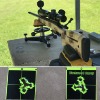Nature Boy
Member
- Joined
- Apr 21, 2015
- Messages
- 8,277
I got out to the range this weekend for the first time in weeks and decided I'd see if there was a difference in accuracy between wet and dry tumbling on my .308 loads.
I recently bought the FART to process pistol brass because the range pick up is generally very dirty. This is where I think wet tumbling makes sense, however, I decided to see how it did on my Lapua .308 brass.
I'll say this, from a shinny stand point I see no appreciable difference between wet and dry, but, it does clean the primer pockets and inside the case. This is where I was curious. Does cleaning the inside the case remove some of that beneficial carbon in the neck that's supposed to reduce bullet seating friction. My conclusion:
1. I noticed no difference in felt resistance when seating, nor was their a difference in OAL after
2. A few of the case's mouths were dented. Does wet tumbling cause this? Anyone else see that?
3. Regarding accuracy fired 2 groups, 5 shots each at 200 yards. The difference between wet (left) and dry (right), dirty necks, clean pockets, shinny, shinny-er, etc.....nada

Bottom line. I'll wet tumble for range pick up pistol brass but think I'll just stick to dry tumbling for my rifle brass. It's just easier
I recently bought the FART to process pistol brass because the range pick up is generally very dirty. This is where I think wet tumbling makes sense, however, I decided to see how it did on my Lapua .308 brass.
I'll say this, from a shinny stand point I see no appreciable difference between wet and dry, but, it does clean the primer pockets and inside the case. This is where I was curious. Does cleaning the inside the case remove some of that beneficial carbon in the neck that's supposed to reduce bullet seating friction. My conclusion:
1. I noticed no difference in felt resistance when seating, nor was their a difference in OAL after
2. A few of the case's mouths were dented. Does wet tumbling cause this? Anyone else see that?
3. Regarding accuracy fired 2 groups, 5 shots each at 200 yards. The difference between wet (left) and dry (right), dirty necks, clean pockets, shinny, shinny-er, etc.....nada

Bottom line. I'll wet tumble for range pick up pistol brass but think I'll just stick to dry tumbling for my rifle brass. It's just easier


